C X DALTON BOSTON OPTICAL WORKS IMPROVED TOLLES LARGE MICROSCOPE STAND B WithCASE
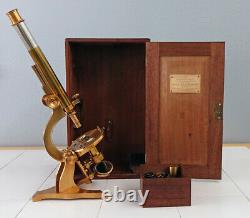
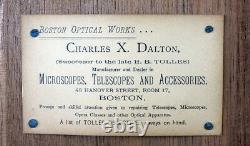

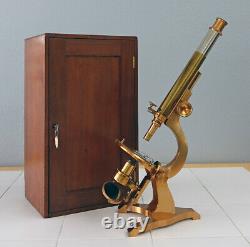
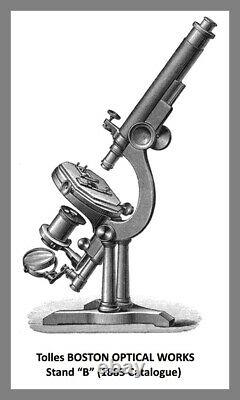
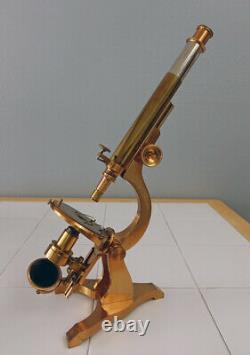
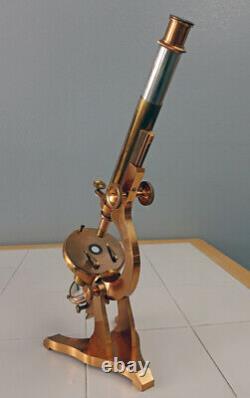
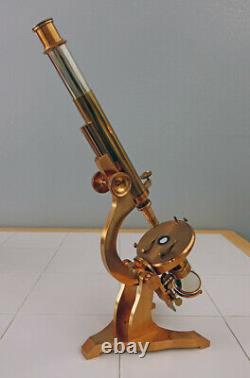
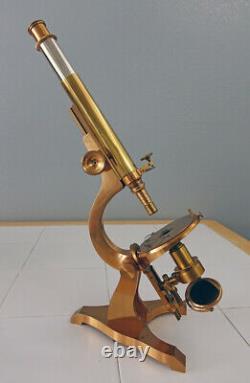
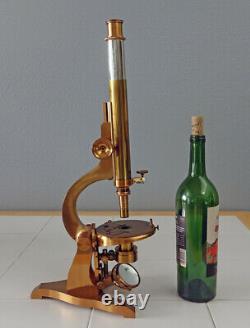

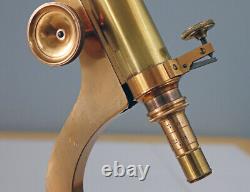

C X DALTON BOSTON OPTICAL WORKS IMPROVED TOLLES LARGE MICROSCOPE STAND B W/CASE. C X DALTON BOSTON OPTICAL WORKS IMPROVED TOLLES LARGE MICROSCOPE STAND B WITH OAK CASE? Dalton of Boston Optical Works, Boston, MA. S improved version of Robert B.
Included with the microscope itself are its original Oak wood case with working lock and key and a set of optical accessories, including a Tolles objective? All of which are described in detail below and illustrated with several accompanying images. The microscope stand that you see here is unsigned and does not bear a typical serial number. S stands that are signed usually do not bear a serial number. However, this instrument clearly bears all the basic identifying earmarks of a Tolles/Boston Optical Works Large Stand B, but with some of Dalton?S improvements that we will highlight below. Accompanying this listing is a catalogue illustration of Tolles Stand B that was extracted from my personal copy of the 1883 Boston Optical Works Catalogue. In comparing the catalogue cut with the images of the listed instrument we see several exact similarities including the shape of the large wide? Shaped foot, the beautifully carved sweeping Jackson limb, the presence of Tolles? Thin stage, the indented cup-shaped course focus knobs, and the fine focus control found on the distal end of the body tube.
The size of the instrument is also directly comparable based on descriptions of Stand B found in the Boston Optical Works Catalogue. Added to this is the fact that the featured instrument bears a Tolles objective lens along with the fact that the wood case that houses the instrument bears Charles X. S trade card identifying the contents as a Boston Optical Works product. S improvements to this Stand B: Most obvious is the fact that Dalton has replaced the twin cylindrical brass pillars used by Tolles with twin trunnion plates.
Secondly, Dalton has modified this Stand B with the addition of a swinging substage apparatus that is able to facilitate oblique illumination below the stage and also to allow the substage mirror even to be carried above the stage to provide for incidental illumination of opaque specimens (Please see the accompanying composite image that shows this feature). This latter improvement was formerly only available on Tolles Large Stand A, but was adapted by Dalton for use on Stand B. This microscope is built upon a large wide V-shaped foot of solid brass. Rising from the foot are twin brass trunnion plates that ultimately terminate in a trunnion joint that captures the lower limb and allows for adjustable inclination. Oversize brass knobs on either side of the joint allow the tension to be adjusted and the stand to be locked in place at any angle.
It is of interest that the foot at the bottom of the V is notched, so that the swinging substage apparatus fits nicely within the notch when the microscope is inclined at the vertical position and the substage apparatus is at the full negative vertical position. Mechanically attached to the lower limb at the trunnion joint with two screws is Tolles? It is of the typical Tolles profile, thicker at the rear nearest the limb and tapering to thinner for most of the rest of its profile. As the description in the Boston Optical Works latter catalogues state, this thin stage? Can admit light of great obliquity, ? By allowing the substage apparatus to swing unhindered to various angles in two directions under the stage. Inset into the stage frame is a brass stage plate with a 14mm diameter central aperture.The stage plate is able to rotate a full 360 degrees. Three centering/arresting screws are found at the periphery of the stage along with a pair of slide clips atop the stage Note: Unfortunately, one (1) of the three centering/arresting screws is broken off. Also found at the top edge of the stage is a conical fitting for a stage forceps (stage forceps not included). Located between the rear of the stage frame and the lower limb at the trunnion joint is a?
To which is attached a brass tailpiece that contains the substage apparatus. The circular track is able to rotate about the axis of the stage to allow the tailpiece to be set at various angles below the stage or even to move above the stage. (Note: Please refer to the accompanying composite image that shows this feature).
Mounted on the tailpiece is the substage illumination apparatus consisting of a yoke mounted 50mm diameter plano-concave mirror and a cylindrical condenser assembly. The entire assembly is focused by rack and pinion. The condenser is so mounted that, by loosening a set screw, it can be rotated laterally to the right or left or even removed entirely from the assembly thereby permitting the tailpiece with the mirror alone to be extended to above the stage. Then too, the mirror itself is mounted on a cylindrical post that can also be moved closer to or away from the stage, rotated to the right or left, or alternately, removed completely from the apparatus by loosening another set screw mounted on the side of the supporting device.
(Note: Please see the accompanying close-up images of the substage apparatus to help you visualize how the condenser and mirror are mounted). NOTE: Our research shows that according to information published in the Journal of the Royal Microscopical Society Volume 3, Part 2 dated January 1880 beginning on page 1055 under the heading, ? As far back as 1875 Tolles experimented with adding a swinging substage to his Stand B. In fact, one of his microscope technicians named Orlando Ames developed a workable solution under Tolles?Supervision that required little modification to the stand. (See page 1063 for details).
Dalton likely knew of these early experiments and used the results to produce the improved Stand B found here. Rising from the rear of the trunnion joint is the beautifully sculpted Jackson limb that is so characteristic of Tolles? Large stands both A and B.At the top of the limb is the dovetail track that holds the body tube of the microscope. Coarse focus is by horizontal rack and pinion controlled by a pair of indented cup-shaped bass knobs found on either side of the upper limb. Fine focus is achieved by a combination spring loaded lever and micrometer screw found at the lower end of the body tube.
Note: While most microscope manufacturers in both the US and Europe abandoned this method of fine focus in favor of other methods by the 1880s, Tolles and Dalton retained it and even perfected it. It still provides a very good level of fine focus even to this day.
Mounted at the lower end of the body tube is a Tolles combination 3-inch/2-inch objective with standard RMS threads. Included with the objective is a brass canister for storage of the objective when not in use on the microscope. Also included with the microscope is a second unmarked objective (appears to be a 1-inch objective).
It comes with a screw on cap for its upper end, but no brass canister. At the top of the body tube is a nickel-plated graduated drawtube with a brass ocular holder at the top. Two (2) unmarked oculars are included with the microscope?
One high power eyepiece and one low power eyepiece. One other included accessory is a prism camera Lucida that can be mounted on the top of either one of the included eyepieces. An image of all the included optical components associated with this stand accompanies this listing. This Dalton/Tolles/Boston Optical Works Improved Large Model B Stand is a relatively large instrument, measuring some 21 inches tall with the drawtube fully extended and weighing 10 pounds.
To illustrate its size, please refer to the accompanying image that compares the height of the instrument to a standard bottle of wine? Quite impressive to say the least. Accompanying this microscope is its original dark Oak wood case that includes a working lock with key and an interior accessory drawer for storage of the eyepieces, objective lenses and other optical accessories when not in use on the microscope. The case also once had a carrying handle, but that feature is now missing.Attached to the inside of the case door is Dalton? S trade card See close? Up image of the card identifying him as Tolles?
The size of the case is 18-inches tall by 10.5 inches wide by 8 inches deep. The weight of the microscope + wood case + all included accessories totals 19 pounds. NOTE: The accompanying images are a part of this statement of condition. Please take the time to view all of the accompanying images.
They are designed to show the instrument at various angles. The instrument was photographed under natural light conditions. The images illustrate some of the salient features as noted in this description and will give you a good idea of what you will be getting should you be the proud new owner of this superb and extremely rare model antique brass microscope. All in all this is a very well preserved example of Dalton? In summary, it is in excellent cosmetic, optical and mechanical condition.
The brass work on this instrument is in absolutely superb condition at a level that we might refer to as? Original lacquer retention is as close as possible to 100% for an instrument that is at least 135 years old and counting. There are just a few very small spots of tarnish mainly on the base, but you will need to look hard to find them. The only cosmetic treatment we have given this instrument was to clean it of dirt and grime with dilute Windex and then to give it a protective coating of Renaissance Wax from THE GEMMARY to preserve it.NOTE: WE MAKE IT A FIRM PRACTICE NOT TO DEEP CLEAN AND POLISH ANTIQUE BRASS MICROSCOPES. The optical elements that come with this microscope including the eyepieces, objective lenses and the condenser are all in excellent condition with no evidence of fogging, fungus, delamination or other defects.
The concave side of the plano-concave mirror is in excellent condition, but the plano side is fogged over (See image). Even though the plano side of the mirror has this defect, it still provides adequate illumination to the stage. Mechanically, both the coarse and fine focus mechanisms work smoothly and flawlessly.The stage rotates freely without binding. However, as noted above, one of the three (3) centering/arresting screws on the side of the stage is broken off.
In addition, the swinging substage assembly works smoothly and the rack and pinion focus mechanism associated with the substage illumination assembly works smoothly. The dark Oak wood case that houses this microscope is in very good serviceable condition and is structurally sound. It is the original wood case for the microscope and even includes a working lock with key.
Typical of virtually all antique wood microscope cases, this case has some surface scratches and dings both inside and outside from use over the years. There is evidence that the case at one time had a carrying handle, but this feature is now missing from this case.This antique brass microscope with case will most certainly be a highly prized addition to any microscope collection, especially one that specializes in some of the somewhat lesser known but highly skilled US microscope manufacturers. DALTON & BOSTON OPTICAL WORKS BRIEF HISTORY. In 1844, he was apprenticed to the lens and microscope maker, Charles A.
About the year 1858, Tolles established his own business in Canastota primarily making very excellent objective lenses? A specialty that he learned from his apprenticeship with Spencer. By 1859, he was fabricating microscopes with Charles E. Grunow, another early American microscope maker. During his early years Tolles made major innovations in the optics of microscopes and held several patents.
In 1867, Tolles received, through Mr. Charles Stodder, a proposition from several Boston businessmen to move his optical business to that city and organize it under the name of The Boston Optical Works, with himself as superintendent. The offer was accepted, and the business carried on in this way for four years, when it was deemed best to place the business entirely in the hands of Tolles, but with Stodder continuing to act as both company treasurer and sole agent for the sale of microscopes made by the firm.
An early catalogue (with no illustrations) issued by the firm in 1870 listed several microscope models including Student? S models and a Clinical Microscope, as well as, several eyepieces, objective lenses and telescopes. Made to order first-class A and B Trunnion Microscopes and Prof. S Inverted Microscopes, Improved, for Chemists. The first-class Trunnion Microscopes were also alluded to in early advertisements by the firm that appeared in Boston trade journals. However, these advertisements tended to feature only the Student?S Microscope with an image along with a brief description. By 1873, the firm had expanded its catalogue to include an illustration of the Student? S Microscope with detailed description.
Also included for the first time was an illustration and description of the Large Microscope Stand B along with an illustration of Tolles? Only a cursory mention of Tolles? Largest Stand A was included. Subsequent editions of this catalogue issued through the year 1883 followed this exact same format. After Tolles died on the 17th of November 1883, the business was carried on by Charles X. Dalton, who had worked for Tolles making metal microscope and telescope stands since his Canastota days and who had moved with him to Boston. During the Civil War, he served as an army nurse. At the close of the war, he became employed by Robert B. Tolles in Canastota, New York. When Tolles relocated to Boston in 1867 to establish the Boston Optical Works, Dalton followed. During his employ with Boston Optical Works Dalton was entrusted with the making of the metal work for Tolles' microscopes and telescopes, and this work was very highly praised. After Tolles died in 1883, Dalton carried on the business of the Boston Optical Works at 30 & 48 Hanover Street, Room 17 making repairs on Tolles? In October of 1886, Dalton issued a notice to?Parties using microscopes and telescopes? Tolles had manufactured microscopes and objective lenses.
Successor to the late R. During this time period it is believed that Dalton made the microscope stands based on Tolles? Designs, but using optics left over from Tolles? He also made some improvements to Tolles?
Original designs, but, evidently he never issued any new catalogues. It appears that he continued the business of manufacturing and repairing microscopes until at least the year 1895. In his later years, Dalton made most of the repairs on the microscopes and chemical balances of the Harvard Medical School, MIT, Wellesley College, Vassar College and most other educational institutions in the Boston area. Dalton died in Boston in 1912. We will also entertain your best offers for this fine instrument. FREE scheduling, supersized images and templates. Make your listings stand out with FREE Vendio custom templates! Over 100,000,000 served. Get FREE counters from Vendio today! The item "C X DALTON BOSTON OPTICAL WORKS IMPROVED TOLLES LARGE MICROSCOPE STAND B WithCASE" is in sale since Monday, November 8, 2021. This item is in the category "Collectibles\Science & Medicine (1930-Now)\Scientific Instruments\Microscopes, Lab Equipment". The seller is "mtloggera" and is located in Hamilton, Montana.This item can be shipped worldwide.
- Antique Brass Microscope: Tolles Improved Large Stand B
- Country of Manufacture: Boston, MA USA
- Manufacturer: Charles X Dalton/Boston Optical Works
- Product Type: Microscopes, Lab Equipment
- Country/Region of Manufacture: United States

